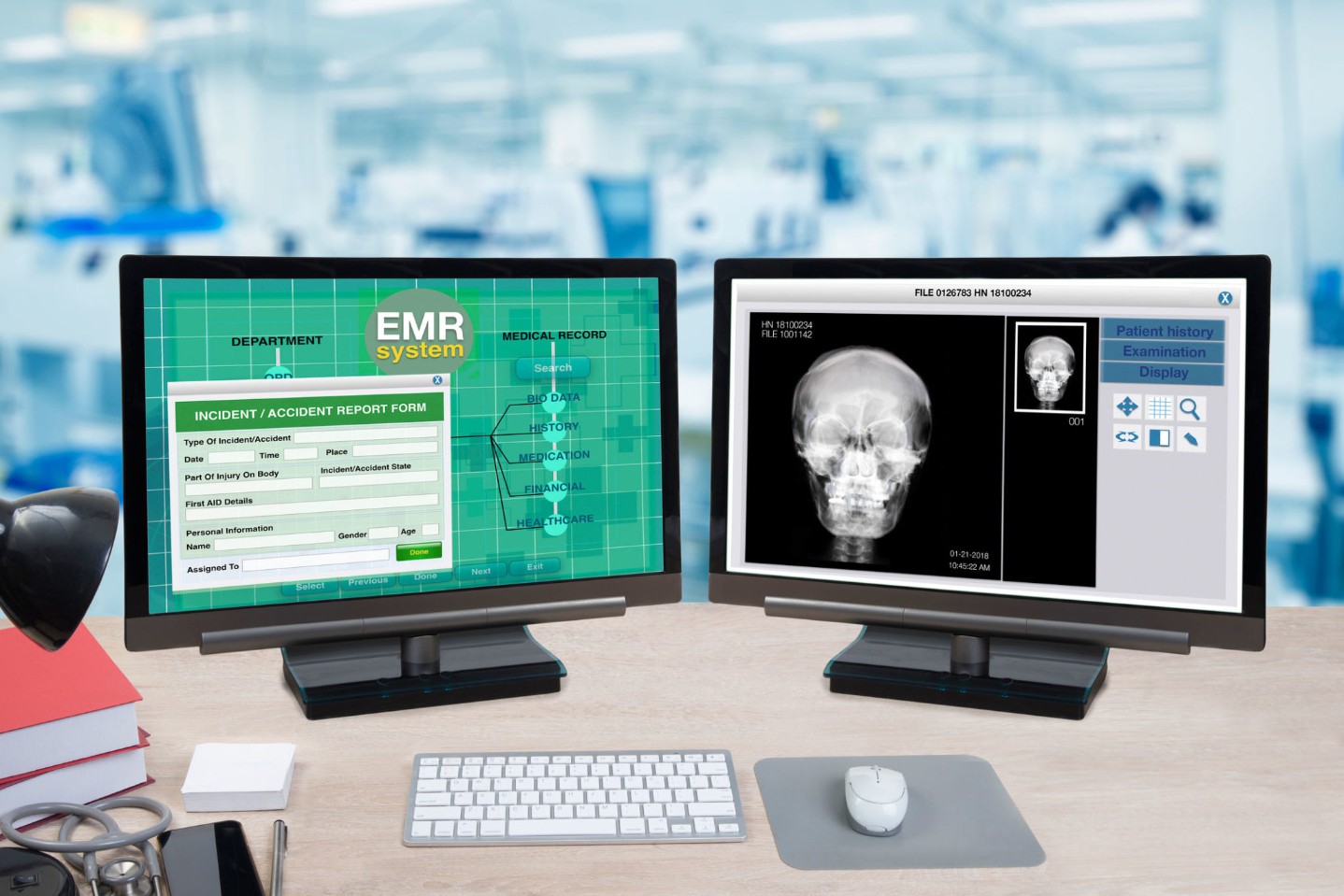Our multispecialty clinic is in the process of converting our standard paper charts to computerized files by adopting an electronic medical record (EMR) system. To say the least, this conversion has been the source of many gray hairs and stomach ulcers for nearly all personnel involved and raises the hackles of our doctors more than almost any other topic. My cardiology group made this transition about 7 months ago and it’s taken me this long for my strong sentiments to simmer to a level where I can produce a somewhat dispassionate discussion (never mind the fact that 6 months ago I would’ve had to type with only one hand, the other being occupied pulling out my hair).
First, a little history about medical records. Doctors have been making notes about the care of their patients for centuries for lots of really good reasons: as a form of communication to other caregivers; out of intellectual curiosity or for research purposes; or mostly because they, like I, have trouble remembering every detail about every patient they treat. Paper has been the universal format for this documentation ever since papyrus and parchment went out of style. Until recently, all doctors maintained a thick, variably organized chart on each patient into which new notes and test results were filed and from which, like socks in a dryer, others occasionally disappeared.
Now we have computers. In 2009, logically bundled into the American Recovery and Reinvestment Act (the “stimulus bill”), we received a mandate to transition all hospital and clinic records to some type of computerized, digital format. As health-care providers, our income will be rewarded or penalized based on our compliance by the deadline of 2015.
When we were initially introduced to EMR we were told (by the makers of the program) that we would become more efficient, safe, and thorough once we adopted their product. I can now say, without a doubt, that these claims were wildly overstated. However, unlike many other doctors who rant against EMR in hallways, doctors’ lounges, and blogs, I am favorably inclined toward this new technology while at the same time fully cognizant of its shortcomings.
So, here’s my simple critique of the realistic advantages and disadvantages of EMR:
Advantages of EMR
- For me the most valuable aspect of EMR is my ability to access it from virtually anywhere. I can pull up a patient’s chart from an emergency room or from my home computer and someday will likely be able to access all information from a portable device. No longer do I have to wait until the office opens on Monday to get a hold of the chart.
- Doctors’ handwriting is the stuff of legend. I was half tempted to scan a snippet of medical hieroglyphics and display it for the benefit of those of you who’ve never seen it, but I decided against it—not out of privacy concerns, but rather because I don’t want to be responsible for triggering PTSD among my readers who are nurses.
- Our notes are considerably more thorough with EMR. The computer system forces us to address oft-skipped issues such as family history, unhealthy habits, long-forgotten procedures, and drug intolerances. This information carries forward with each note and is always available.
- Our accounting people tell us that our billing is more streamlined with EMR. I know this sounds like a trivial issue but the fact remains that we, too, must make money or we go out of business. Our reimbursement is based solely on documentation, and the more thorough we can be in our notes, the more Medicare or your insurance will pay us appropriately for the work we are already doing.
- Our particular EMR (I believe most others do this as well) allows us to provide prescription refills rapidly and nearly error-free. We can send medication orders directly to your pharmacy so that your drugs are ready when you arrive. This simple function can save us an immense amount of time.
- I have heard from several primary care doctors how much they appreciate how rapidly we can provide documentation of the services we provide their patients. This is thanks to the ability to electronically transmit a copy of our note within minutes after the patient’s visit.
Disadvantages of EMR:
- Since the portal to the EMR is the computer terminal instead of the pen, the patient experience suffers when doctors attempt to put together notes in the exam room while talking to the patient. This is the complaint I hear more than any other when it comes to patients’ experiences with our new system: “My doctor spent the whole visit staring at the computer screen.” The method that works best for me is to build my note before and after I see the patient and to never access the computer in the exam room, an approach that allows me to devote my entire attention to the patient during their visit.
- The language found in most EMR-produced notes is stilted, mechanical, and sometimes difficult to interpret. Years ago doctors prided themselves on the fluidity and descriptive quality of their documentation and went to great lengths to impart the nuances of their patient interactions. This is all lost in a chart where most of the information comes from pick-lists and check-boxes. Read this recent article from the New York Times to get a sense of one doctor’s frustration with this type of system.
- It is slow. If ever a rep from any EMR company tries to convince you of the efficiency of EMR, please refer them to me and I’ll introduce them to some of my business associates from Nigeria. In the course of one uncomplicated office note I am required to click the mouse so many times you’d swear I was translating Moby Dick into Morse code. We have a relatively good voice recognition system, but in the best of hands (or tongues) it is fraught with errors. (If I enunciate the sentence “Dr. Satpathy would like to order Pradaxa on a patient undergoing aquapheresis” it comes out like this: Doctor's the past he would like to order per DACs on a patient undergoing aqua for recess.) The current generation of EMR software is nowhere as quick as a Dictaphone.
- Having an extremely thorough medical record has a downside: information overload. When all medical information is distilled to a database we have difficulty sifting what is truly important from what is trivial. I saw a young woman last week who was sent from a doctor whose office uses EMR and I was able to review the doctor’s most recent note before seeing the patient. The list of diagnoses contained at least 20 items and I was surprised to walk into the exam room and meet a very healthy young lady who had few of the problems described. Why her note stated otherwise comes down to how patient complaints are documented. In order to bill for the visit the doctor has to select a diagnosis from a list of approved terms, rather than simply describing a symptom. Thus, simple aches and pains mentioned in passing become diagnoses that stick with the patient (a stiff knee becomes degenerative joint disease, a cough becomes bronchitis, constipation becomes irritable bowel syndrome). As I looked over the patient’s diagnosis list I realized that none of them represented real medical problems.
- Our EMR in particular puts a great deal of emphasis on using the computer as the intermediary in the course of clinical communication. Prior to our adoption of EMR, if a patient called with a question our nurse would take down the details and call me for a response. I could then call the patient with the answer or have the nurse handle the problem. Now the system is considerably different. The patient’s question gets sent to a “tasking in-box” where it will languish along with dozens of lab and x-ray results until I log on to a computer to address them. During a day of hospital rounding and procedures I can’t reliably address my in-box on a regular basis. Now instead of patients’ questions being answered immediately with a conversation with the nurse, the patient’s request may not be addressed for hours or days. To make matters worse, the system for communicating with our own nurses involves more steps than it took for the engineers with slide rules to land Apollo 13.
The final issues I’d like to discuss are patient safety and cost containment. These are the two features that were heavily advertised by the government when the EMR provision was added to the 2009 bill. Global adoption of EMR was supposed to decrease medical errors and thereby save the US healthcare system $80 billion. This particular argument for EMR was best refuted in a Wall Street Journal opinion authored by the chair of medicine at the Harvard Medical School. My personal opinion is that this is nothing more than wishful thinking as I have yet to come across a situation where my computer has saved me from committing an error in the course of patient care.
In the end I have to confess that I like EMR despite the fact that our particular system is cumbersome, poorly structured, unintuitive, inflexible, and clearly designed by someone who hates the carpal tunnels of all doctors. I like being able to provide my patient a note as they walk out the door; I appreciate having full access to their history when I see them in the ER in the middle of the night; I love having a list of all their prior procedures and surgeries at my fingertips; and, most of all, I value the legibility of Times New Roman over Doctor Scrawl Italic.



